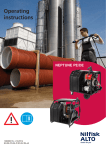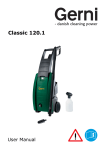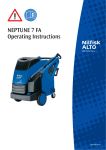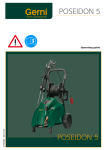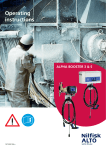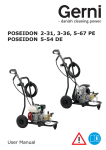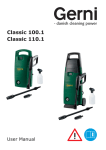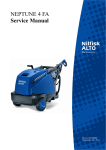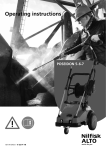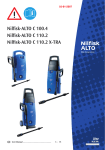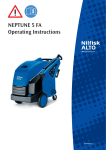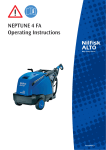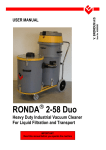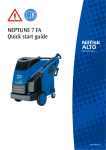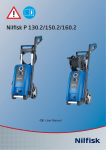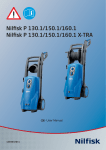Download alpha booster 3 & 5
Transcript
ALPHA BOOSTER 3 & 5 !,0(!"//34%2 User Manual 2 34% // !" 0( !, ER ST OO AB PH AL 5 Contents 1 Important safety instructions ..................................................................................4 2 Description 2.1 2.2 Purpose ................................................................................6 Operating elements ..............................................................6 3 Before starting the washer 3.1 Installation environment .......................................................7 3.1.1 Temperature conditions.............................................7 3.1.2 Conditions of distance...............................................7 Mounting instructions ...........................................................7 Setting up the machine.........................................................8 Connecting the high pressure hose......................................8 Connecting the water supply ................................................8 Electrical connection ............................................................8 3.2 3.3 3.4 3.5 3.6 4 Operation 4.1 4.2 4.3 5 Applications and methods 5.1 5.2 Connecting the spray lance to the spray gun .......................9 Switching on the washer ......................................................9 4.2.1 Switching on the washer when it is connected to a water supply .......................................................9 4.2.2 Switching on the cleaner when it is connected to open tanks (suction mode)....................................9 Using detergents ................................................................10 General information ............................................................11 5.1.1 Soaking ..................................................................11 5.1.2 Detergent and foam ................................................11 5.1.3 Temperature ...........................................................11 5.1.4 Mechanical effect ....................................................11 5.1.5 High water flow or high pressure ...........................11 Some typical cleaning ........................................................12 5.2.1 Agriculture ...............................................................12 5.2.2 Vehicles ...................................................................12 5.2.3 Building & construction / industry............................13 6 After using the machine 6.1 6.2 Switching off the machine ..................................................14 Disconnecting supply lines .................................................14 7 Maintenance 7.1 7.2 Maintenance plan ...............................................................14 Maintenance work ..............................................................14 7.2.1 Cleaning water inlet filter.........................................14 7.2.2 Checking the pump oil level ....................................15 7.2.3 Changing the pump oil ............................................15 8 Troubleshooting 9 Further information ...............................................................................16 9.1 9.2 9.3 9.4 Recycling the washer .........................................................17 Guarantee ..........................................................................17 Technical Specifications .....................................................17 EU Declaration of Conformity .............................................17 3 1 Important safety instructions Symbols used to mark instructions For your own safety The high-pressure washer may only be used by persons instruc ed in its use and who have been expressly authorised to do so. Although extremely easy to operate, children should not be allowed to use the washer. General Use of the high-pressure washer is subject to the applicable local regulations. Besides the operating instructions and the binding accident prevention regulations valid in the country of use, observe recognised regulations for safety and proper use. Do not use any unsafe work techniques. 4 Before using the high-pressure washer, be sure to also read the enclosed operating instructions and keep them within reach at all times. This symbol is used to mark safety instructions that must be observed to prevent damage to the machine and its performance. Safety instructions in these operating instructions which must be observed to prevent risks to persons are marked with this danger symbol. This indicates tips and in structions to simplify work and to ensure safe operation. Before starting the washer We strongly recommend that the power supply to the high pressure washer be connected via a residual current circuit breaker. If your washer was supplied without a plug, have it fitted with a suitable plug with earth conductor, by an electrician. Before use, check that the highpressure washer is safe and in proper condition. Regularly check whether the electric cable is damaged or shows signs of ageing. Use the high-pressure washer only when the electric cable is in a safe condition. (risk of electric shock if damaged!). Check the rated voltage of the high-pressure washer before connecting it to the mains power supply. Ensure that the voltage shown on the rating plate corresponds to the voltage of the local mains power supply. This device stops the supply of electricity if the leakage current to earth exceeds 30 mA for 30 ms or it has an earth tester circuit. Please observe the regulations and provisions applicable in your country. Before putting the high-pressure washer into service, carry out a visual check of all the major components. CAUTION! High-pressure water jets can be dangerous if misused. The jet must not be directed at persons, animals, live electrical equipment or the washer itself. Wear appropriate protective clothing and eye protectors. Do not direct the jet towards yourself or towards other persons in order to clean clothes or footwear. During operation of the washer, recoil forces are produced at the spraying device and, when the spray lance is held at an angle, a torque is also created. The spraying device must therefore be held firmly in both hands. Do not use the washer when other people without protective clothing are in the working area. Check that cleaning will not result in dangerous substances (e.g. asbestos, oil) being washed off the object to be cleaned and harming the environment. Do not clean delicate parts made of rubber, fabric, etc. with the 0° jet. Keep some distance between high pressure nozzle and surface in order to prevent the surface from damage. Operation Maintenance and repair CAUTION! Unsuitable extension cords can represent a source of danger. Always unwind cord from the reels completely to prevent the electric cable overheating. CAUTION! Always disconnect the machine from the mains plug socket before cleaning or carrying out maintenance work on the washer. When using an extension cord, connectors must be of watertight construction. Carry out only the maintenance operations described in the operating instructions. Use only original spare parts. Do not make any technical modifications to the high-pressure washer. When using an extension cord, check the minimum cross-sections of the cable: Cable length m Cross section <16 A up to 20 m ø1.5mm² ø2.5mm² 20 to 50 m ø2.5mm² ø4.0mm² <25 A Do not damage the electric cable (e.g. by driving over it, pulling or crushing it). Disconnect the electric cable by pulling the plug only (do not pull or tug the electric cable). Electrical equipment Do not use the high-pressure hose for lifting loads. NOTE! The specifications of the highpressure hose (max. permissible pressure and temperature) are printed on the hose. Do not continue to use the washer if the electric cable or high-pressure hose is damaged. Ensure adequate air circulation. Do not cover the washer or operate it in inadequately ventilated rooms! Store the washer where it will not be exposed to frost! Never operate the washer without water. Even brief shortages of water result in severe damage to the pump seals. CAUTION! Never spray electrical equipment with water: danger for persons, risk of shortcircuiting. The washer may only be connected to a correctly installed plug socket. Switching on the washer may cause voltage fluctuations. Voltage fluctuations should not occur if the impedance at the transfer point is less than 0.15 Ω. If in doubt ask your local electricity supplier. Ensure that the machine is regularly serviced by Authorised dealers in accordance with the maintenance plan. Failure to do so will invalidate the warranty. CAUTION! High-pressure hoses, fittings and couplings are important for the safety of the washer. Use only high-pressure parts approved by the manufacturer! If the electric cable is damaged, it must be replaced by authorized Service or an electrician to avoid danger before use of the cleaner is continued. Use only the type of electric cable specified in the operating manual. Please contact the Service department or an authorised specialist work-shop for all other maintenance or repair work! Testing The washer conforms to the German „Guidelines for Liquid Spray Jet Devices“. The high-pressure washer must be subjected to a safety examination in accordance with the „Accident Prevention Regulations for Working with Liquid Spray Jet Devices“ as required, but at least every 12 months, by an authorised inspector. 5 After all repairs or modifications to electrical equipment, the protective conductor resistance, the insulation resistance and the leakage current must be measured. Furthermore, a visual inspection of the electric cable, a voltage and current measurement and a function test must be carried out. Our after-sales service technicians are at your disposal as authorised inspectors. The complete „Accident Prevention Regulations for Working with Liquid Spray Jet Devices“ are available from the Carl Heymanns Verlag KG, Luxemburger Strasse 449, 50939 Cologne or from the appropriate association of employers’ liability insurances. Unloader valve Unacceptably high pressure is fed back without residual pressure via a bypass line into the intake line of the pump when the safety device is tripped. The unloader valve is set and sealed at the factory and must not be adjusted. 2 Description 2.1 Purpose Always use the washer as described in these operating instructions. Any other use may damage the washer or the surface to be cleaned or may result in severe injury to persons. 2.2 Operating elements See fold-out page at the front of these operating instructions. 6 1 2 3 4 5 Electric cable Spray gun High-pressure hose Spray lance Supply water connection with water inlet filter 6 High pressure hose connection 7 Main switch 8 Wall bracket 3 Before starting the washer 3.1 Installation environment 3.1.1 Temperature conditions The machine should be installed in a frost-free room. This applies to pump as well as pipelines incl. of outlet points. -AX# -IN# Concerning outdoor outlet points, it should be possible to close and empty that part of the line which is exposed to frost. The maximum ambient temperature for the machine is 40°C. 3.1.2 Conditions of distance -INMM -INMM 3.2 Mounting instructions ATTENTION: Beware that the machine weighs approx. 40-60 kg. Choose fasteners and screws suited for this weight. Out of consideration for the cooling system of the machine and the accessibility of service, there must be wall space on both sides of the machine. To the right 150 mm at a minimum and to the left 400 mm at a minimum. The recommended installation height fot he machine is max. 1700 mm and min. 1550 mm to the upper edge of the machine. 1. Hold the mounting bracket against the wall and mark the hole positions. 2. Drill four holes at the size matching the fasteners to be used. Pre-mount the fasteners and the screws. 3. Mount the machine onto the bracket's four rubber feet and fasten with the enclosed washers and nuts. 4. Hang the assembly of machine/bracket on the four pre-mounted screws and tighten. 7 3.3 Setting up the machine 1. Before using the machine for the first time, check it carefully to detect any faults or damage. 2. In the event of any damage contact your dealer immediately. 3. Check whether the oil level is between the minimum and maximum marks. If necessary, add oil (see section "9.3 Technical Specifications" for type of oil). CAUTION! Never lift the machine alone (weight 40-60 kg). Always ask a second person to help. 3.4 Connecting the high pressure hose 3.5 Connecting the water supply 1. Attach the high pressure hose to the high pressure inlet by means of the quick coupling. - water break tank (coming with this product). See separate instructions on how to install the water break tank. Do not connect the washer directly to the public drinking water mains. Obsererve the regulations of your water supply company to prevent backflow of water into the supply line. A connection is permitted, however: - briefly to a pipe interrupter with moving section - with a free outlet 3.6 8 Electrical connection See section "9.3 Technical Specifications" for required quantity of water and water pressure. In the case of poor water quality (sand, etc.), we recommend that a fine water filter is fitted in the water inlet. 1. Rinse the water supply hose briefly in order to prevent sand an other dirt particles entering into the machine. 2. Connect water supply hose to the machine (3/4"). 3. Open water tap. CAUTION! The washer may only be connected to a correctly installed electrical installation. 1. Observe safety instructions in section 1. 2. Mount the electrical cable to a fixed wall outlet or mount a suitable plug and connect to a socket. Observe correct amperage ! 4 Operation 4.1 A Connecting the spray lance to the spray gun C B NOTE! Always remove any dirt from the nipple before connecting the spray lance to the spray gun. 4.2 Switching on the washer 4.2.1 Switching on the washer when it is connected to a water supply Operate the spray gun several times at short intervals to vent the system. 1) 2) A delay of 20 sec. is incorporated Accessory 1. Turn the main switch to position " 1 ". 2. Unlock the spray gun and operate it. 3. Lock the spray gun even during short pauses. The washer switches off automatically1) after the spray gun has been closed. To start the washer again, operate the spray gun. NOTE! 4.2.2 Switching on the cleaner when it is connected to open tanks (suction mode) 1. Pull the blue quick-release grip (A) of the spray gun forwards and lock it by turning it to the left. 2. Insert the nipple of the spray lance (C) into the quick-release connection and turn the blue quick-release grip to the right (B). 3. Pull the spray lance (or other accessory) forwards to check that it is securely attached to the spray gun. 1. Before connecting the detergent intake set 2) to the cleaner, fill the hose with water. 2. Turn the main switch to position »I«. 3. Unlock the spray handle and activate it. Max. suction height = 1 m. 9 4.3 Using detergents Detergentscan be drawn in via the injector installed as standard only in low-pressure mode: CAUTION! Never allow detergents to dry on the surface to be cleaned. The surface may be damaged. 10 1. Dilute detergents according to the manufacturer's instructions. Capacity, see section 9.3 Technical Data. 2. Tornado lance 1) : Set pressure regulation on spray lance to low pressure (-), or Flexo Power 3000 nozzle 1): Turn cap of the Flexo Power 3000 nozzle towards "CHEM" up to the stop. 3. The intaken volume of detergent can be regulated by turning the metering valve. 4. Main switch: Turn the switch to position "I". 5. Activate the spray gun. 1) Options / model variants 5 Applications and methods 5.1 General information Efficient high pressure cleaning is achieved by following a few guidelines, combined with your own personal experience of specific cleaning tasks. Accessories and detergents, when correctly chosen, can increase the efficiency of your pressure washer. Here is some basic information about cleaning. 5.1.1 Soaking Incrusted or thick layers of dirt can be loosened or softened up by a period of soaking. This is for example an ideal method within agriculture – for example, within pig sties. The ideal soaking method can be achieved via use of foam or simple alcaline detergent. Let the product lie on the dirty surfaces for around 30 minutes before pressure washing. The result will be a much quicker high-pressure cleaning process. 5.1.2 Detergent and foam Foam or detergent should be applied onto dry surfaces so that the chemical product is in direct contact with the dirt. Detergents are applied from bottom to top, for example on a car bodywork, in order to avoid “super clean” areas, where the detergent collects in higher concentration and streams downwards. Let the detergent react several minutes before cleaning off. 5.1.3 Temperature Detergents are more effective at higher temperatures. Greases, oils and fats can be broken down more easily at higher temperatures also. Proteins can be cleaned at temperatures of around 60°C. Oils, pollution and grease can be cleaned between 70° and 90°C. 5.1.4 Mechanical effect In order to break down tough layers of dirt, additional mechanical effect may be required. Special lances and rotary or wash brushes offer this supplementary effect that cuts through dirt. Use a brush to cut through e.g. traffic film. 5.1.5 High water flow or high pressure High pressure is not always the best solution and high pressure may damage surfaces. The cleaning effect also depends upon water flow. Pressure levels of around 100 bar may be sufficient for vehicle cleaning (in association with hot water). Higher flow levels give the possibility to rinse and flush away large amounts of dirt easily. 11 5.2 Some typical cleaning tasks 5.2.1 Agriculture Task Accessories Method Stables Pig Pens, sties Foam Injector Foam lance Powerspeed lance Floor Cleaner Powerlift lance 1. Soaking – apply foam to all surfaces (bottom to top) and wait for approx 30 minutes. 2. Remove the dirt from surfaces with the high-pressure lance or chosen accessory. Clean from bottom to top on vertical surfaces. 3. To flush away large quantities of dirt, change to lowpressure mode and use the higher flow to push away the dirt. 4. Use recommended disinfectant products and methods to ensure hygiene. Only apply disinfectants once the dirt has been fully removed. Cleaning of walls, floors and equipment Disinfection Detergents Universal Alkafoam Disinfectant DES 3000 Standard lance Detergent injector Powerspeed lance Curved lance and underchassis washer Brushes 1. Apply detergent to vehicle or equipment surfaces in order to soften up dirt and grime. Work from bottom to top. 2. Proceed with cleaning using the high-pressure lance. Clean again from bottom to top. Use accessories to clean in difficult to reach places. 3. Clean fragile areas such as motors or rubber parts at lower pressure levels to avoid damage. Task Accessories Method Vehicle bodywork Standard lance Detergent injector Curved lances and underchassis washer Brushes 1. Apply detergent to vehicle or equipment surfaces in order to soften up dirt and grime. Apply from bottom to top. In cases of particularly dirty vehicles, pre-spray with a product such as Allosil in order to remove traces of insects etc, then rinse at low pressure and apply normal car cleaning detergent. Let detergents settle for five minutes before cleaning off. Metallic surfaces can be cleaned using RimTop. 2. Proceed with cleaning using the high-pressure lance. Clean again from bottom to top. Use accessories to clean in difficult-to-reach places. Use brushes in order to add a mechanical cleaning effect. Short lances can help for cleaning of motors and wheel arches. Curved lances or the undercarriage washer are also ideal for the cleaning of car underchassis and wheel arches. 3. Clean fragile areas such as motors or rubber parts at lower pressure levels to avoid damage. 4. Apply a liquid wax using the pressure washer in order to protect the bodywork from pollution. Machinery Tractors, ploughs etc. 5.2.2 Vehicles Detergents Aktive Shampoo Aktive Foam Sapphire Super Plus Aktive Wax Allosil RimTop 12 5.2.3 Building & construction / industry Task Accessories Method General surfaces Foam injector Standard lance Curved lance Tank cleaner 1. Apply thick foam over the surfaces to be cleaned. Apply on dry surface. Apply from top to bottom on vertical surfaces. Let the foam act for up to 30 minutes for the optimal effect. 2. After this time, clean down with the high-pressure lance or relevant accessory. Use high pressure to dislodge large amounts of incrusted dirt or grime. Use lower pressure and high water volume in order to flush away loose dirt and rinse surfaces. 3. Apply DES 3000 disinfectant once the surfaces are perfectly clean. Metallic equipment Detergents Intensive J25 Multi Combi Aktive Alkafoam Disinfectant DES 3000 Rusted or damages surfaces prior to treatment Wet Sandblasting equipment Areas covered by amounts of loose dirt, such as animal remains in slaughterhouses, can be removed by using high water flow to flush away the dirt to evacuation pits or drains. The tank cleaner can be used to clean barrels, vats, mixing tanks etc. Tank cleaners may be hydraulically or electrically powered and give the possibility for automatic cleaning without constant monitoring. 1. Connect the sandblasting equipment to the pressure washer and place the suction tube in the sand. 2. Always wear protective equipment during sandblasting. 3. Spray the surfaces to be treated with the mix of water and sand. Rust, paint etc will be stripped off. 4. Following sandblasting, protect surfaces against rust (metal) or rot (wood). These are merely examples of cleaning tasks that can be solved by a pressure washer in association with accessories and detergents. Each cleaning task is different, so please consult your local dealer or Gerni representative in order to discuss the best solution for your own cleaning problem. 13 6 After using the machine 6.1 6.2 Switching off the machine 1. Turn the main switch to position " 0 ". 2. Close water tap. 3. Squeeze the spray gun handle until the washer is depressurised. 4. Lock the safety catch on the spray gun. Disconnecting supply lines 1. Switch off the mains supply. 2. Close all outlet taps and/or remove hoses. 7 Maintenance 7.1 7.2 Maintenance plan Maintenance work Weekly 7.2.1 Cleaning water inlet filter Q 7.2.2 Checking pump oil level Q 7.2.3 Changing pump oil 7.2.1 Cleaning water inlet filter After the first 50 operating hours Every six months or 400 operating As required hours Q Q Q A water filter is fitted on the water inlet to prevent large particles of dirt from entering into the pump. 1. Unscrew the quick-release connection. 2. Remove the filter and rinse it. Replace damaged filter. 14 7.2.2 Checking the pump oil level 1. Check whether the oil level is between the minimum and maximum marks. If necessary, add oil (see section ‘9.3 Technical Specifications’ for type of oil). 7.2.3 Changing the pump oil 1. Unscrew the oil drain plug (1) on the pump housing and dispose of the old oil in accordance with the disposal regulations. 2. Check the drain plug gasket and screw in the plug again. 3. Fill with fresh oil and close the oil filler plug. CAUTION! Special pump oil is required if the washer is used near food. Please consult your dealer. Oil grade and capacity see section ‘9.3 Technical Specifications’. 15 8 Troubleshooting Fault Cause Remedy Pressure drop > Air in the system • > High pressure nozzle blocked • worn Clean/replace the high pressure nozzle. > Pump draws in air (only possible in suction mode) • Check that the suction set is air-tight. > Lack of water • Open water tap. > Water inlet hose is too long or its cross-section too small • Use specified water inlet hose. > Injector open • Close injector. > Detergent container empty • Refill detergent container. > Lack of water caused by blocked water filter • Clean the water filter in the water connection (never work without water filter) > Lack of water because max. permissible suction height has not been observed • See instructions, section 4.2.2. > The plug/mains is not connected properly, i.e. there is no current • Check the plug, cable and mains switch and if necessary have them replaced by a trained electrician. > The mains fuse is switched off • Switch on/exchange the mains fuse. > The mains voltage is too low or there is a phase failure. • Have the electrical connection checked. > The pump is blocked • Contact the customer service > Incorrect cross-section or length of the extension cable • Use cable with correct cross section or length. > The overload protection has been activated due to overheating or overloading of the motor • Check that the mains voltage and the machine voltage are the same. Switch off the machine and allow it to cool for at least 3 minutes. > High-pressure nozzle is dirty • Change the high-pressure nozzle. Pressure fluctuations The motor does not start when the washer is switched on When the washer is switched on the motor buzzes without starting The motor switches off Any other failure: Contact your nearest Gerni service centre. 16 Vent the system by operating the spray gun several times at short intervals. If necessary, operate the washer for a short time without the high-pressure hose connected. 9 Further information 9.1 Recycling the washer If the washer is discarded, make it unusable immediately 1. Unplug the washer and cut the electric cable. The washer contains valuable 9.2 Guarantee Our general conditions of business are applicable with regard to the guarantee. Subject to 9.3 materials that should be recycled. Therefore, make use of your local waste disposal site. Contact your local authorities or your nearest dealer for further information. change as a result of technical advances. Technical Specifications ALPHA BOOSTER 3-26 ALPHA BOOSTER 5-49 Voltage V 240 400 Fuse (slow) A 16 16 3.3 6.9 135 180 kW Power rating Working pressure bar Water volume l/h 600 970 Water volume QIEC l/h 570 900 Cleaning impact kg/force 2.6 4.9 Max. water inlet temperature (Intake-/Pressure operation) °C 50 50 Max. water supply pressure bar 10 10 Dimensions l x w x h mm 560 x 350 x 370 357 x 643 x 365 Weight kg 39 48 73.5 70.8 88 85 Noise level at a distance of 1m DIN 45635 dB(A) Sound power level Lwa dB(A) Vibration level at spray gun m/s² ≤ 2.5 ≤ 2.5 Thrust N 22 47 Oil quantity l 0.45 0.45 Oil type SAE 15 W 40 Nozzle size 9.4 .0370 .0500 EU Declaration of Conformity EU Declaration of Conformity Product: High Pressure Washer Type: ALPHA BOOSTER 3, ALPHA BOOSTER 5 Description: 400 V 3~, 50 Hz - 230 V 1~, 50 Hz - IP X5 The design of the unit corresponds to the following pertinent regulations: EC Machine Directive EC Low-voltage Directive EC EMV Directive Applied harmonised standards: EN 292-1, EN 292-2, EN 60335-2-79 EN 55014-1, EN 55014-2, EN 61000-3-2 98/37/EEG 73/23/EEG 89/336/EEG Applied national standards and technical DIN EN 60335-2-79 specifications: Nilfisk ALTO Division of Nilfisk-Advance AG Guido-Oberdorfer-Straße 2-8 D-89287 Bellenberg Dipl. Ing. Wolfgang Nieuwkamp Tests and approvals Bellenberg, 01.02.2006 17 Nilfisk-Advance Pty LTd 48 Egerton St Silverwater NSW 2128 107309509 (01.2007) Phone: 1300 556 710




















